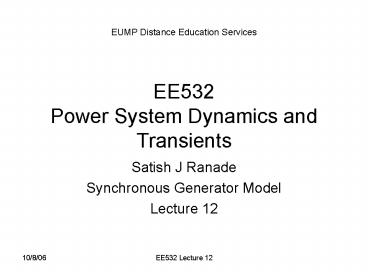EE532 Power System Dynamics and Transients PowerPoint PPT Presentation
1 / 28
Title: EE532 Power System Dynamics and Transients
1
EE532 Power System Dynamics and Transients
EUMP Distance Education Services
- Satish J Ranade
- Synchronous Generator Model
- Lecture 12
2
Topics
- Modeling of synchronous generators
- Advanced stability studies
- Modeling machine in more detail
- Modeling controls
- Exciter/Voltage Regulator
- Results from more detailed modeling
3
- Fields Approach Coupled Coil Model
- Park/Kron/Blondel
- Transformation
- Two reaction theory Transient Studies
- Phasor Model
- Linearized Model
- Steady State Models Stability Studies
4
Modeling of synchronous generators
Circuits approach Using these principles
develop a model for the generator
pd()/dt
? flux linkage ( Kundur Text)
5
Modeling of synchronous generators
Circuits approach Using these principles
develop a model for the generator
Kundur notation Note fd, kd, kq subscripts Note
ia, ib, ic now come out of stator coils
6
Modeling of synchronous generators
Circuits approach Using these principles
develop a model for the generator
Ignore Dampers
Will fold negative sign on ia ib ic into R and
L Will suppress time variable. Remember
everything Is instantaneous value here
7
Modeling of synchronous generators
Circuits approach Using these principles
develop a model for the generator
Laa, etc. are functions of Rotor position ? ?
??dt so T and the inductance terms are
Functions of time
8
Modeling of synchronous generators
Circuits approach Using these principles
develop a model for the generator
Inductance Matrix Stator phase a Laa(?)
LalLgoLaa2 cos (2 ?) Round rotor Laa2 0
Leakage
Field q Axis
?
Field d Axis
a
9
Modeling of synchronous generators
Circuits approach Using these principles
develop a model for the generator
Phase a Axis
Field q Axis
Inductance Matrix Mutual Inductance
a Lab(?) -(1/2)Labo-Lab2 cos (2
?-2p/3) Round rotor Lab2 0
?
Field d Axis
a
Leakage
Field q Axis
?
Field d Axis
a
10
Modeling of synchronous generators
Circuits approach Using these principles
develop a model for the generator
Phase a Axis
Inductance Matrix Mutual Stator phase a-
Field Lafd(?) Lafd cos ( ?)
Field q Axis
a
Field d Axis
Field q Axis
Field d Axis
a
Maximum
Minimum
11
Modeling of synchronous generators
Circuits approach Using these principles
develop a model for the generator
Phase a Axis
Inductance Matrix Field Self Lffd(?) Lffd
Field q Axis
a
Field d Axis
Field q Axis
Field d Axis
a
Maximum
Minimum
12
Modeling of synchronous generators
L(?)
13
Modeling of synchronous generators
dqo transformation
Field current ifd is not transformed Io
(iaibic)/3 is the usual zero sequence current
14
Modeling of synchronous generators
dqo transformation
Direct axis component of stator currents
Quadrature axis component of stator currents
15
Modeling of synchronous generators
dqo transformation interpretation of dq currents
? is an arbitrary variable ( reference
frame) If Stator currents are balanced three
phase positive sequence
Note unconventional convention
Im peak value of line current
16
Modeling of synchronous generators
dqo transformation interpretation of dq currents
d
d
d
a
a
a
q
q
q
t0
t2p/3?
t4p/3?
Three phase statorbal.pos.seq. currentgt Uniform
rotating field
17
Modeling of synchronous generators
d
d
d
a
a
a
q
q
q
dqo transformation interpretation of dq currents
A rotating magnetic field can be created by a
two-phase stator -- coils placed 90 deg
apart -- currents 90 deg out of phase --
simplifies analysis but also practical
18
Modeling of synchronous generators
dqo transformation interpretation
Replaces 3 phase stator by a 2 phase stator
zero sequence circuit
d
d
a
a
q
q
19
Modeling of synchronous generators
dqo transformation interpretation
Transformation to synchronously rotating
reference ??st ?o
d
?s
d
?s
?s
q
q
2 phase stator rotating At ?s dc
Sationary 3 phase stator balanced positive
sequence current at frequency ?s
dc!
20
Modeling of synchronous generators
dqo transformation
dqo inverse transformation
Same transformations for voltage and flux
21
Modeling of synchronous generators
dqo transformation transformed machine
equations
Similar Notation for voltages and flux
eabc R iabc p?abc ?abc L iabc
22
Modeling of synchronous generators
dqo transformation transformed machine
equations
eabc R iabc p?abc ?abc L iabc
T(?)eabc T(?) R T-1(?) T(?) iabc
T(?) pT-1(?) T(?) ?abc edqo T(?) R
T-1(?) idqo T(?) pT-1(?) ?dqo ?dqo T(?)
L T-1(?) idqo
23
Modeling of synchronous generators
dqo transformation transformed machine
equations
edqo T(?) R T-1(?) idqo T(?)
T-1(?) p?dqo T(?) pT-1(?) ?dqo edqo
R idqo p?dqo T(?) pT-1(?)
?dqo ?dqo T(?) L T-1(?) idqo
R is diagonal transformer voltage derivative
of flux Speed voltage
pT-1(?) ? dT-1(?)/d ?
24
Modeling of synchronous generators
dqo transformation transformed machine
equations
pT-1(?) ? T(?) L T-1(?) Ldqo ?
25
Modeling of synchronous generators
dqo transformation transformed machine
equations
T (?)pT-1(?) ?r T (?)d(T-1(?))/d ??
- Effect of rotation (generated voltage) captured
by voltage sources - q axis flux linkage induces speed voltage in d
coil - d axis flux linkage induces speed voltage in q
coil
26
Modeling of synchronous generators
dqo transformation transformed machine
equations
27
Modeling of synchronous generators
dqo transformation transformed machine
equations
The dqo transformation simplifies machine
equations by transforming to a rotating reference
frame on the rotor The three stator coils are
replaced by a pair of orthogonal d-q coils and a
zero sequence coil Result Inductances are no
longer time varying Coil- coil coupling
simplified - no coupling between d and q
28
Modeling of synchronous generators
dqo transformation transformed machine
equations
Next Understanding transformed model Using
model for simple transients Steady state
model Slowly varying phasor model for stability

